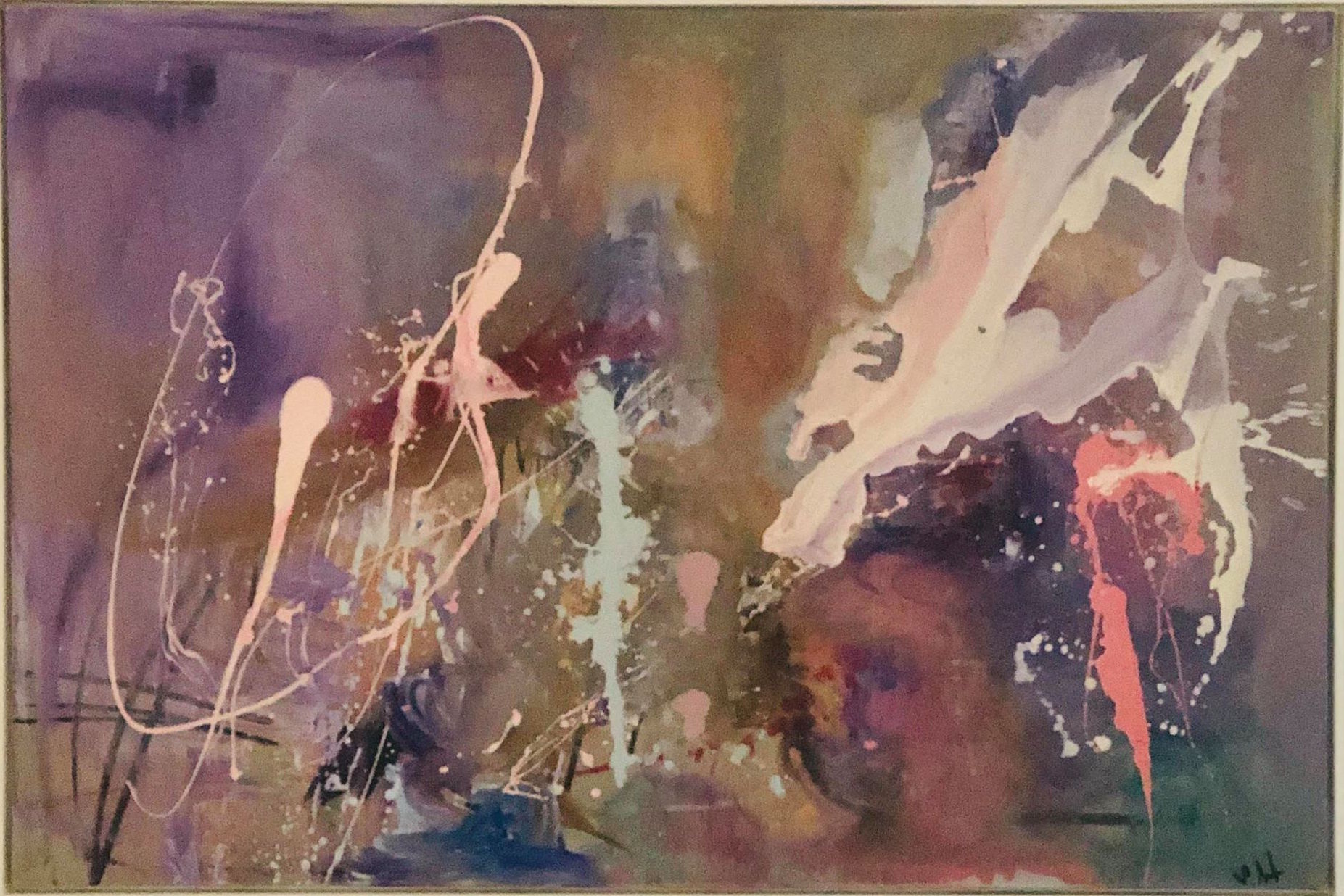Cina Canada, Gyrotonic Headquarters Media Coordinator, sat down for a conversation with Vered Hofton about her identity as an artist. In this interview, she shares that after 12 years of practicing the GYROTONIC® and GYROKINESIS® Methods, a new portal to her inner creativity burst open without warning. With no formal art training, she suddenly began prolifically painting and expressing herself on the canvas.
Vered’s work is now privately commissioned and will be on a debut exhibit at the London Espacio Gallery March 31-April 4, 2020.
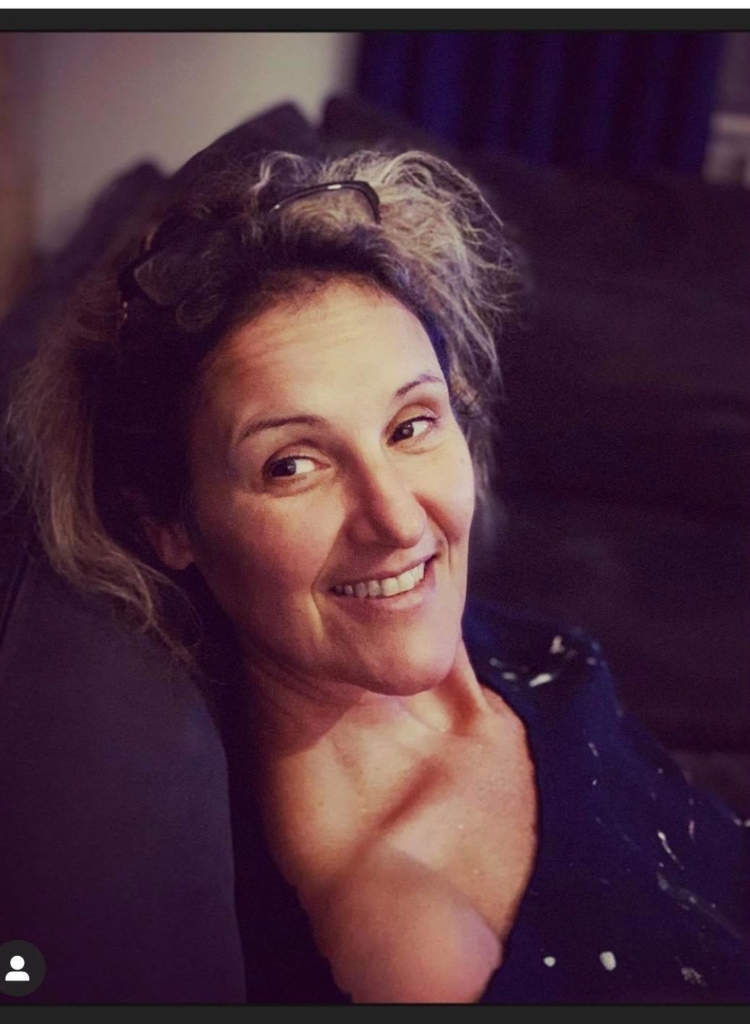
Photo provided by Vered Hofton
Cina: Vered, thank you so much for joining me today.
Vered: Thank you for your interest. It’s very overwhelming to know that other people are interested.
Cina: You know, your story is really something special. I was mostly interested to talk to you because you’ve taken what Juliu has taught, as his personal experience, and you’ve tried to apply that to your own life. You’ve listened to what he said about allowing openness to come. You had hardly anyone to study with. So, let’s give our audience a little taste of how you came to the Gyrotonic Method and where you are now.
Vered: In 2008 I had a conversation with my friend from New York, and I said to her, “So what’s new in the Pilates world?” She said to me, “No, Pilates is over. There is the Gyrotonic Method now.”
I asked, “What is the Gyrotonic Method?” and she said, “I can’t explain. You just have to look on YouTube.” So I opened YouTube and I was mesmerized. I was like, “This is the exercise of the future.”
Two weeks later I booked myself into a course in Israel, where my parents live, with Ronny in Haifa. She didn’t really want to accept me in the course because I had no previous experience, so I said to her, “But I have no one to learn with. You have to let me in the course. I promise I will work hard.” So she did.
I didn’t have any clue what was going on. That was my entrance. I was a fitness instructor. I just knew that there was something in there for me. I had no idea about what I was asked to do with my body, and it was really weird. The whole system was really weird, but I had to keep on. And I wanted to get to where I could have my own Pulley Tower so I could practice myself because I had no teachers.
Cina: You had no one around to help you?
Vered: No one. Only in London, which was very difficult to travel to because I had little babies.
Once I got my Pulley Tower, I placed it in the house and I just practiced night and day, trying to figure it out, trying to understand. I remembered some things from the courses.
And then I started to teach people. We had lots and lots of conversations about it. People came to practice the Pulley Tower, but we also used to talk a lot about what we feel. I let everyone know about that video of Juliu expressing what the Gyrotonic Method is. It’s a beautiful video. Everybody knew about it. So that’s how we tried to understand what it is.
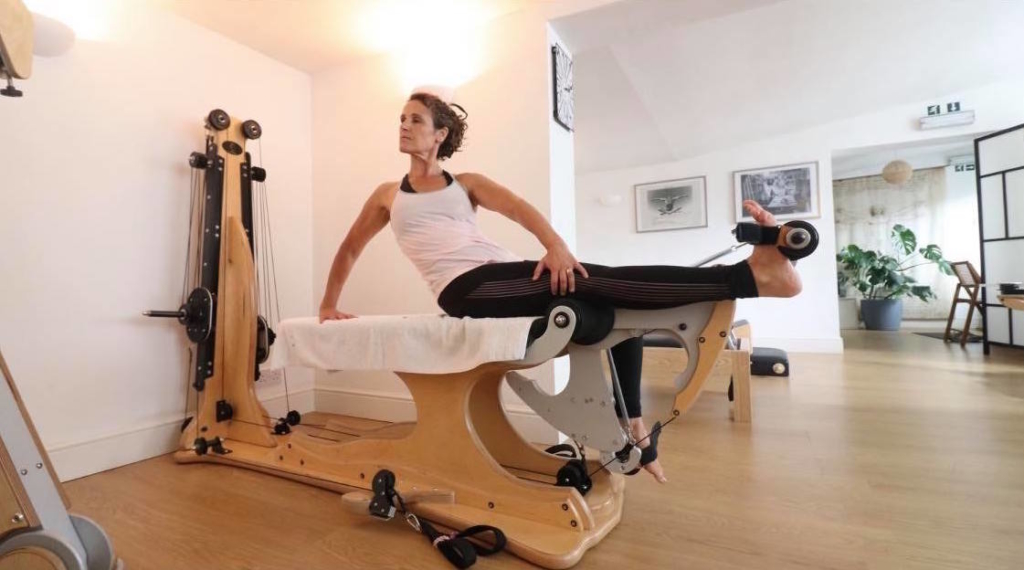
Photo provided by Vered Hofton.
Cina: When you were practicing by yourself with no teacher, what was your experience in trying to uncover the nuances of this work?
Vered: I was doing the bicycle on the Pulley Tower from the hamstring series and I remember my teacher shouting at me, “Don’t bend your knee!” I still remember that. I was like, “What do you mean ‘Don’t bend your knee?’ When you bicycle you have to bend your knee.” So I tried to figure that out, what it means not bending the knee. I tried to do it with less bending the knee. I tried to do it in all different ways. I tried to understand how the breathing works.
I think when you’re repetitively doing it, it just comes to you and then you start to feel things happening inside your body and you listen to it. And that’s the only way. Arch and curl was a complete disaster with my body because I was just using my lower back. I’m very mobile in my lower back, so I was just moving my back. I didn’t really get the up curl. And so I had to just go through the experience and figure out how to do it in a way that felt right. It’s all about feeling. I was developing some kind of intuition, some kind of instinct that I was listening to, rather than following instructions.
Cina: But that requires some degree of awareness of your own body. How did you develop any kind of self awareness?
Vered: I think that that’s what’s very good about the Gyrotonic system. It really develops the awareness of people. When I teach, I just let them be aware and find their own awareness, because when you start to move, you have to listen. What is the movement telling you to do? How do you follow the movement?
I’ve been through so much since then that it’s very hard for me to repeat that experience. It’s just a long, long searching for language. What is there for me? Why do I do that?
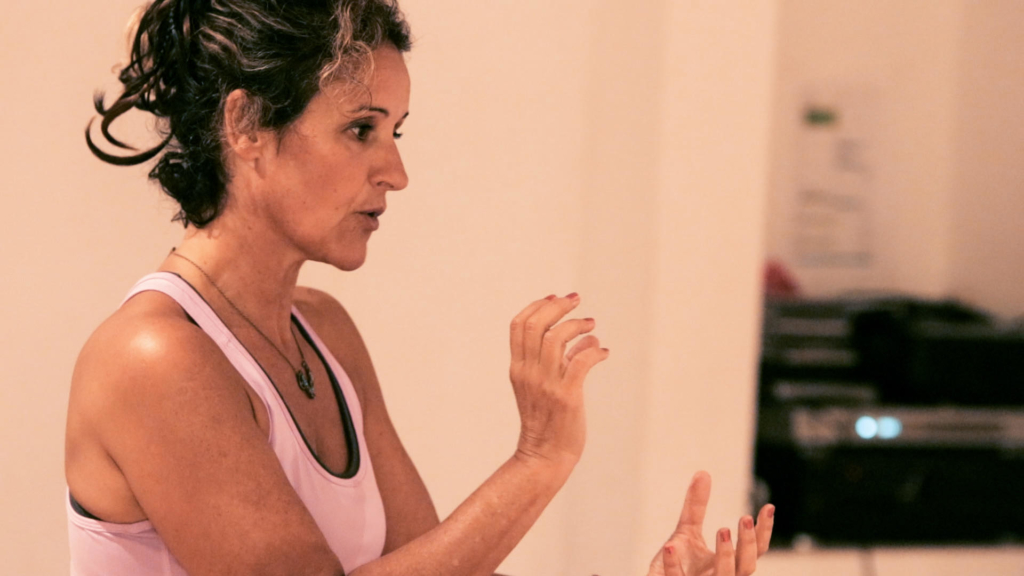
Photo provided by Vered Hofton.
Cina: Tell me about the language. You were just talking about something, that we have to learn a new language of the consciousness.
Vered: After a long, long experience with the Gyrotonic Method and with other things I did, like classical Pilates, to get really deep into my body, I started to realize that I needed a different outlet, not just exercise or movement. I needed to do something else.
So I started to paint the walls in my house different colors. And that was hard work. It came to me that I needed to do a painting on canvas. So I started to paint on canvas, and then I started to realize that there is some kind of therapy there because you don’t know what you are doing, you’re just responding to what’s happening on the canvas.
I started to realize that once you finish the painting, the paint is talking to you. And you get feelings like the movement of the paint, some kind of lines and dots, something happening and you’re looking at it. I then started to realize that it actually feels like a language that people don’t understand in words, but when they look at it, it speaks to them. It’s a different language.
I realized that it’s the same with movement. Movement is language, and the body speaks that movement. It is the only one who knows that language. Your body language will be different than my body language. It’s the same thing with arch and curl when you do the Gyrotonic Method. It will not have the same meaning as I have because I’m expressing it with my body. And when you do it, it will have a different meaning for you because you are expressing it with your body. So it’s just expression.
I think Juliu always mentioned that the Gyrotonic Method is the expression of the body. It’s just expression. And this kind of expression in me translated to painting, which I never, never in my life thought I would do. It just makes me laugh when I say it!
Cina: This is a great transition to you painting. I’d like to preface this that you were not a painter. You did not come from an artistic background.
Vered: Anyone who knows me laughs because they know that in art classes the teacher used to kick me out. My family laughs at me because I have no idea how to draw a chair. Honestly, I don’t have any idea about art.
Cina: Ok, so tell me about this first day where you decided, “I need to express this somehow on a canvas,” if you can remember. What year was it?
Vered: In July of 2018 I saw a woman on Facebook that was teaching, “Painting from the Heart.” So I said to myself, “I must go to see that woman and see what she means by ‘painting from the heart.’ Maybe she will not tell me how to do things. Maybe she will just let me do whatever I want, which I’m good with.”
So I went to this session. It was 7-11 at night. We started with ten minutes of meditation with sound. Then she gave us the canvas and paint and I was completely drawn into it. When I finished at 11:00 everybody was gone. It was only me left, with a lot of paint on my face, on my legs. The teacher laughed at me. She said, “Look at you.” I said, “What?” She said, “You are full of paint.” I was completely drawn into it. The time went like that.
I then understood that there is something in there, that it has to do with therapy, to do with expressing yourself. It’s very deep. I don’t need to speak. I don’t need to tell anyone how I feel. I just do that and I get rid of everything.
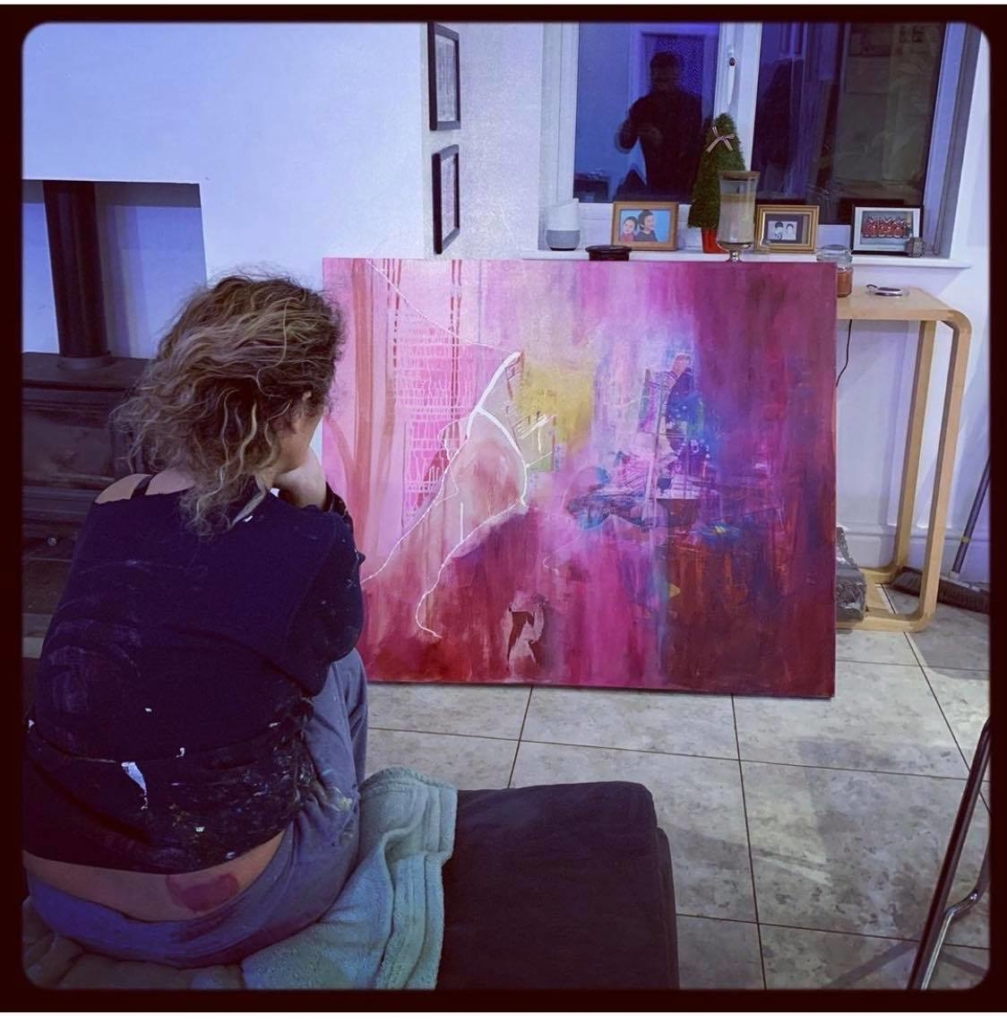
Photo provided by Vered Hofton.
Cina: That’s amazing.
Vered: So, I did three sessions with her and then I thought to myself, “She’s only giving me a very small canvas. I need more paint. I need more canvas.” So I started to buy it for myself, but I realized it’s an expensive thing. I started to buy really large canvases because I felt like I needed more space. And I bought lots of paint. I started to paint. There were lots of fails, and there were lots of moments of, “Oh my, I can’t believe I did it.”
But I think once you start with this, you understand that there are no rules. Things happen by accident. Things happen intuitively, instinctively. And then people look at it and they react to it because it’s language. It’s speaking to them. And then you feel like, “I did it?” It’s kind of a surprise.
Cina: When I saw your paintings, knowing that you’ve only been painting for one year, I thought, “How is this possible?” They’re so sophisticated.
Vered: You know what? It’s possible because one time I did a painting and I was in such a good mood. It was a summer day. I took everything out and then I realized that painting is a moment. You have to really instinctively do what you want to do. You feel like splashing the paint, you splash the paint. You feel like squashing it, you squash it. You feel like pouring water on the canvas? You can torture it. You can do anything to it. It’s your platform.
So I realized that you can’t think. You can’t be structural. You have to respond to your instinct. It’s the same thing as when you finish a Gyrotonic session and everybody just wants to dance. They just want to move. Someone is jumping. Someone is walking fast. Someone is rolling on the floor. You’re just responding to what your body tells you to do.
Cina: You’re expressing.
Vered: Yeah. You have a kind of a whisper, “Throw some water. Throw some water. Take a cloth and squash it. Do some paint with your hands. What else?” Yeah, you never know what will happen. You can’t predict it.
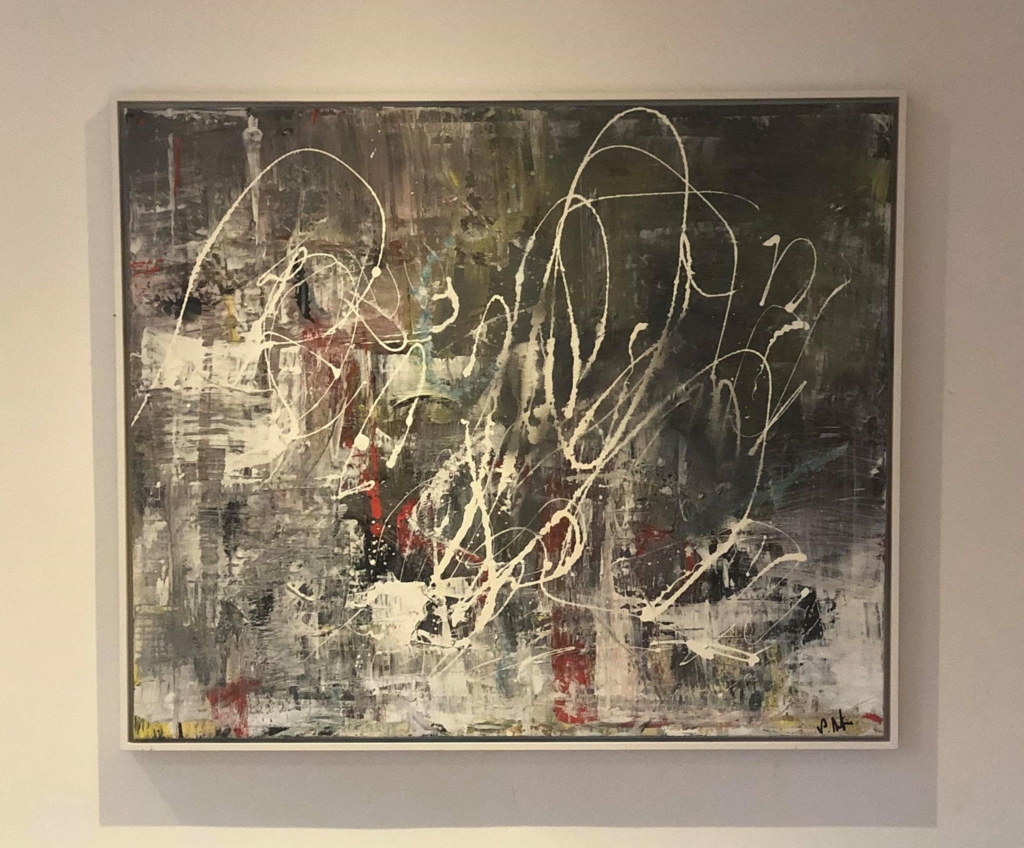
Photo provided by Vered Hofton.
Cina: Juliu talks a lot about this work being his personal creative expression. So here, just like you’ve talked about before, he’s expressing through movement, through what he was given. And it sounds like you’re having that same experience in movement and…
Vered: Paint.
Cina: Tell me about that.
Vered: You have to find some kind of trust in yourself. It’s about you telling yourself what to do rather than someone else telling you what to do. You have to follow your own path. Juliu said one time, I think, I don’t want to quote wrong, but it was like, “Nobody told me to do it. It’s nature.”
And for me it’s the same thing with art. It’s just the nature. Maybe you don’t like the painting but somebody else likes it. It’s not about someone liking it or not liking it. It’s not about aesthetic. It’s about yourself. What do you want to say right now? And it just comes to you as a form of a mess on the canvas. Some people will say, “Oh, it’s disgusting. I don’t like it. It’s too chaotic.” But then, I think, if you keep working on the canvas, it will start coming to harmony or some kind of balance. It’s a whole world. It’s another reality that’s happening at the same time.
Cina: You mentioned earlier that you feel like this openness and this sudden access to your creativity came through movement.
Vered: When I started the Gyrotonic Method I was a fitness instructor. I was very temperamental, very fiery, very sharp. And when I started the Gyrotonic Method, I had to change. And I did change a lot. I had lots of blockages across my body. I did lots of treatment on my body. Because of the Gyrotonic Method I was looking for this openness, and I knew that it was not there. I knew my neck was locked. I knew my shoulders were not responding – all the things that people feel when they move. And I did lots of treatments, lots of body work looking for answers for pains and aches. And I think now after so many years I have this sense of openness. And this type of openness, I think what it does is really open me up in terms of feelings and emotions. It’s opened my heart, basically. And my heart has become so big, so full of love, full of happiness. So I think the canvas is where I’m able to express my deep feelings. And that comes from movement.
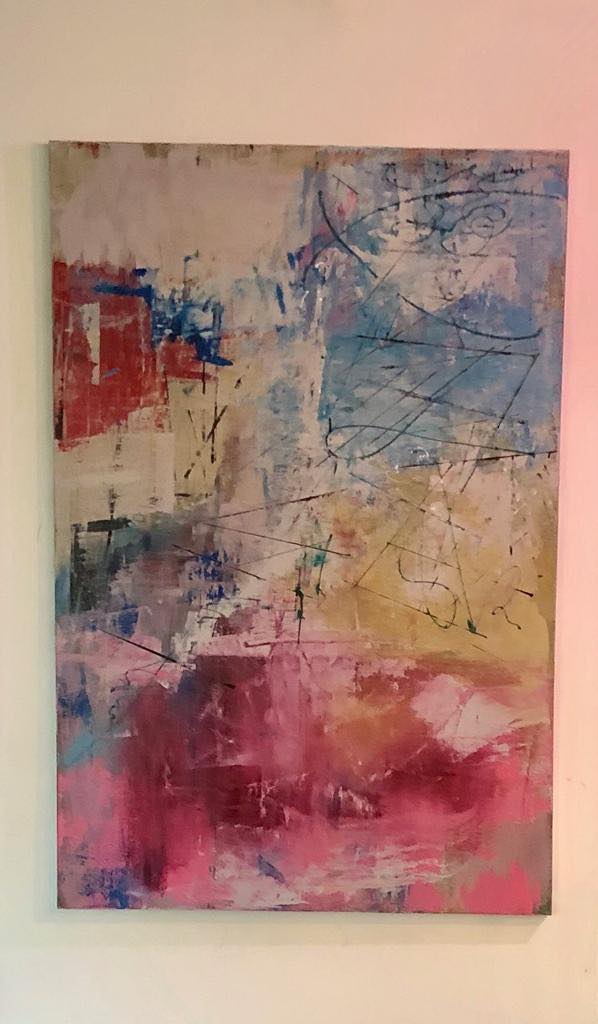
Photo provided by Vered Hofton.
Cina: What is it about movement, though, that opens up those pathways?
Vared: I think it’s the energy flow. When you move, you have to be open enough so you can feel the energy flow through your body, like waves. If you do arch and curl it comes from the feet. It starts to go up, up, up, up, and then to go down, down, down. There is a kind of a wave feeling to everything you do. It’s up and it down. It’s flow. And it’s rhythm. You learn about rhythm.
Even when you see me paint, there is a moment when I’m really fast, fast, fast, fast, and then the rhythm changes and then there is quiet. And there is a moment where you just do something and then you stop. It’s very rhythmic.
Cina: People talk about energy all the time. But like you said, you were blocked. Could you physically tell when the energy started to move in new ways? Or did it just happen?
Vered: It has a lot to do with me trying to release the stiffness that I always felt in my upper spine. My neck, shoulders, throat, and chest were always tight. When I was a fitness instructor I used to shout a lot. I started to get very tense. And I actually had to stop doing the aerobic. I don’t do any aerobic. I do lots of deep, slow breathing.
I had to change my whole nature. I had to become more soft, more relaxed. To slow down. It was a process of years. I remember when I tried to slow down and be really careful not to get too excited or too energetic, I started to feel like it was a boring life. What do you do with this quietness? You need to slow down. You need to relax.
Today I understand that it comes in waves. If I’m too excited, I need to calm down a little bit. If I’m too relaxed, I need to wake up a little bit. It’s kind of like the rhythm of life. And that kind of rhythm is following you in movement. It’s following you on the canvas. It’s following you all the time.
Cina: So why do you think that movement opened up artistic creativity for you? Energy can open up all sorts of different things.
Vered: Because I always struggle with expression. I struggle with expression when talking. Even talking to you I struggle. I always felt, even as a child, that nobody listened to me and nobody understood what I was saying — not only in English, also in Hebrew. I’m just not good with words.
My husband has always encouraged me to do what I do and he thinks that I’m very, very creative. But I always have this frustration and think, “No, you don’t understand.” And the thing is that when you do your painting, you don’t need to understand anything. It’s almost like, who cares? Who cares what you’re saying? It’s all there on the canvas. I put it there. You take it and you feel it for yourself and think for yourself, but I’m not responsible anymore for what you’re understanding. Do you know what I mean?
Cina: Absolutely.
Vered: This responsibility of having to express myself so that people understand me is very, very frustrating. When you do it on the canvas you go through the process and you express and that’s it. It’s leaving you. It’s not there anymore. It could be negative emotion. It could be anything. That’s why it’s therapy, I think. It’s the language of your subconscious. It doesn’t make any sense. It’s like talking gibberish.
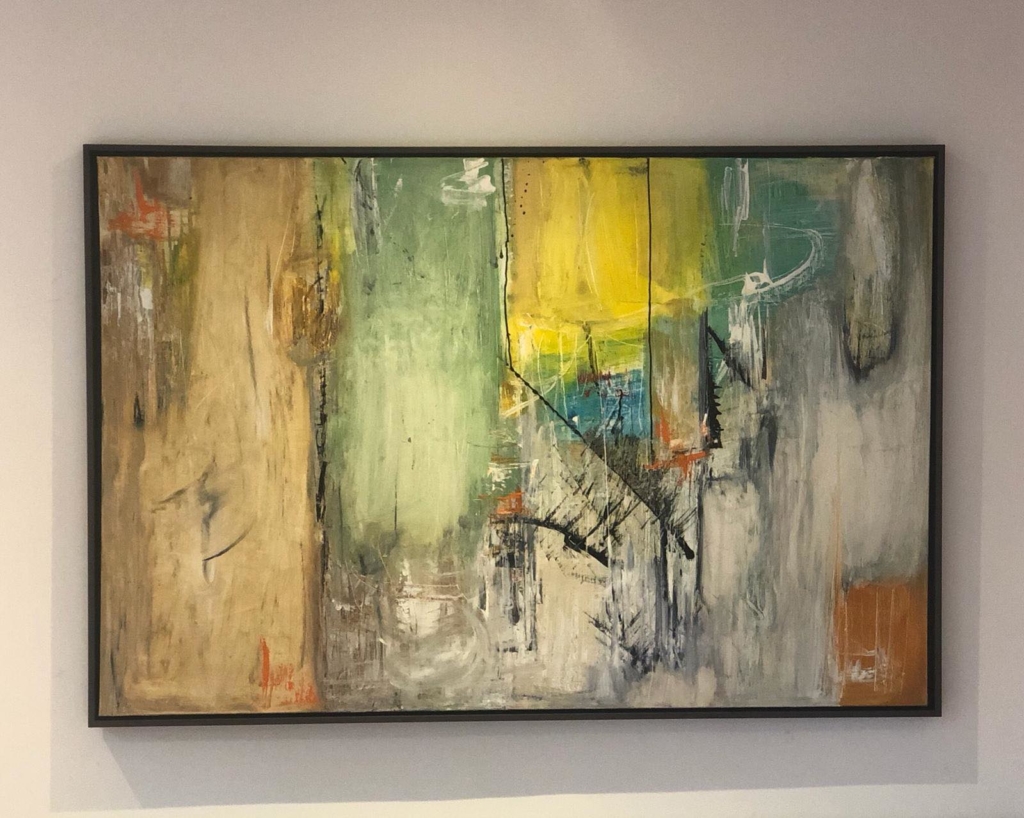
Photo provided by Vered Hofton.
Cina: So what is your purpose?
Vered: When I started the Gyrotonic Method, I wanted everybody to do it. Now I have the same feeling. I want everybody to go to the canvas and paint because I think it’s that easy. All you need to do is just be yourself. It’s that easy. Just don’t worry if it’s nice or not. You feel blue, take blue. You feel white, take white. Do you want to mix them? Mix them. Don’t think. Just do it instinctively. And I think that will release a lot of tension from yourself.
Cina: A lot of people hear Juliu’s words, but somehow you took those and…
Vered: I never met Juliu. I never had a Master Trainer to work with, just courses that I had to do. I did lots of exploration by myself because the moment I saw the first video of the Gyrotonic Method I felt like it was for me. I felt like there was something for me here. This opening of the heart, you know the arch, when you lift your heart up and you look up to the sky, this is what captured me the most. And I think I needed it at that time.
Cina: So what is it you want to continue to give people, moving forward?
Vered: I want people to feel expression in everything that they do, and not feel the responsibility that they need to do things right, that if they fail somebody will kill them.
I think we, as humans, are all artists. We are artists of life and we’re here to express our nature. And everyone has a different nature. Even the most boring job can be some kind of self expression. And I think that people need to find their own self expression.
Cina: And self expression does not necessarily mean you’re going to be a painter. It doesn’t mean you’re going to be a musician.
Vered: No. You can be a gardener. You can drive on a bus and do an interesting route and talk to people and see things. There is expression in everything. Life is expression, so you want to find it in everything you do.
Cina: Where do you want to go from here with your art?
Vered: I don’t think about this at the moment. I’m quite comfortable because I’m in a place where I have my studio. I have my work. I have my family. I’m in a very comfortable way, so I just want to keep exploring so that every picture is surprising. I don’t know what will happen with the next picture. And every picture that I do is a process that I’m going through. You never know where it’s going to take you, like I never knew that I was going to paint. Never in my life. Ever. If you asked me ten years ago, “Do you think you will do something like that?” I would have said, “No.”
I think that what I can do in the future is basically have the client do his session, and then go to the gallery and paint, and then go home. It’s good. It’s like a special program: Gyrotonic Method and Art. It’s expression of life.

Photo provided by Vered Hofton.
Cina: It’s expression. It is self expression and that’s exactly where this work came from. This work came from a self expression from Juliu.
Vered: Yes. There is no right and wrong, even if people don’t do the movement right. One day they will do it the way they feel is right for them because that’s how they feel it in their body. At the beginning when I started the Gyrotonic Method, I thought that I needed to do things a certain way. Then I started to realize you just need to follow yourself.
Cina: Well, it’s like you said, your body speaks a different language than my body.
Vered: Yep. I will not look like you. Even if we do the same movement, we will never be able to move the same. That’s what I think. It’s like how you never have the same painting as the other. Everyone paints differently.
I’ve changed so much in the last 20 years, and I think the Gyrotonic Method has been a big, big psychological treatment. It had a big, big, massive, massive impact on my life.
Cina: Why? You’ve been doing movement for many many years. Why is the Gyrotonic Method any different? You were doing yoga. You were doing Pilates. You were an aerobics instructor. Why did the Gyrotonic Method do something different?
Vered: Wow. That’s interesting. I never thought about this. Why Gyrotonic? First of all, it’s very unique. Nobody gives you these kinds of movements. Nobody talks about the spine. Well, Pilates does, but Pilates is very controlled and you have to kind of hold yourself upright all the time.
But the Gyrotonic Method is giving you the freedom to move in all different ways. I know that the Gyrotonic Method got me into this place, but I can’t tell you exactly how.
Cina: So how do you know it’s the Gyrotonic Method?
Vered: Because it’s opened me to a place where I had to connect. To feel is a big thing. To feel.
Please leave us a comment below with your thoughts!
About Vered:
Vered is the owner of Tatton House Studio. You can contact her for classes or painting inquires at:
To find Gyrotonic and Gyrokinesis classes near you, visit our Studio Finder tool.
To learn more about how to become a Gyrotonic or Gyrokinesis Trainer, visit our Teacher Training page.

Cina Canada is a GYROTONIC® Trainer and Media Coordinator for GYROTONIC® International Headquarters.

